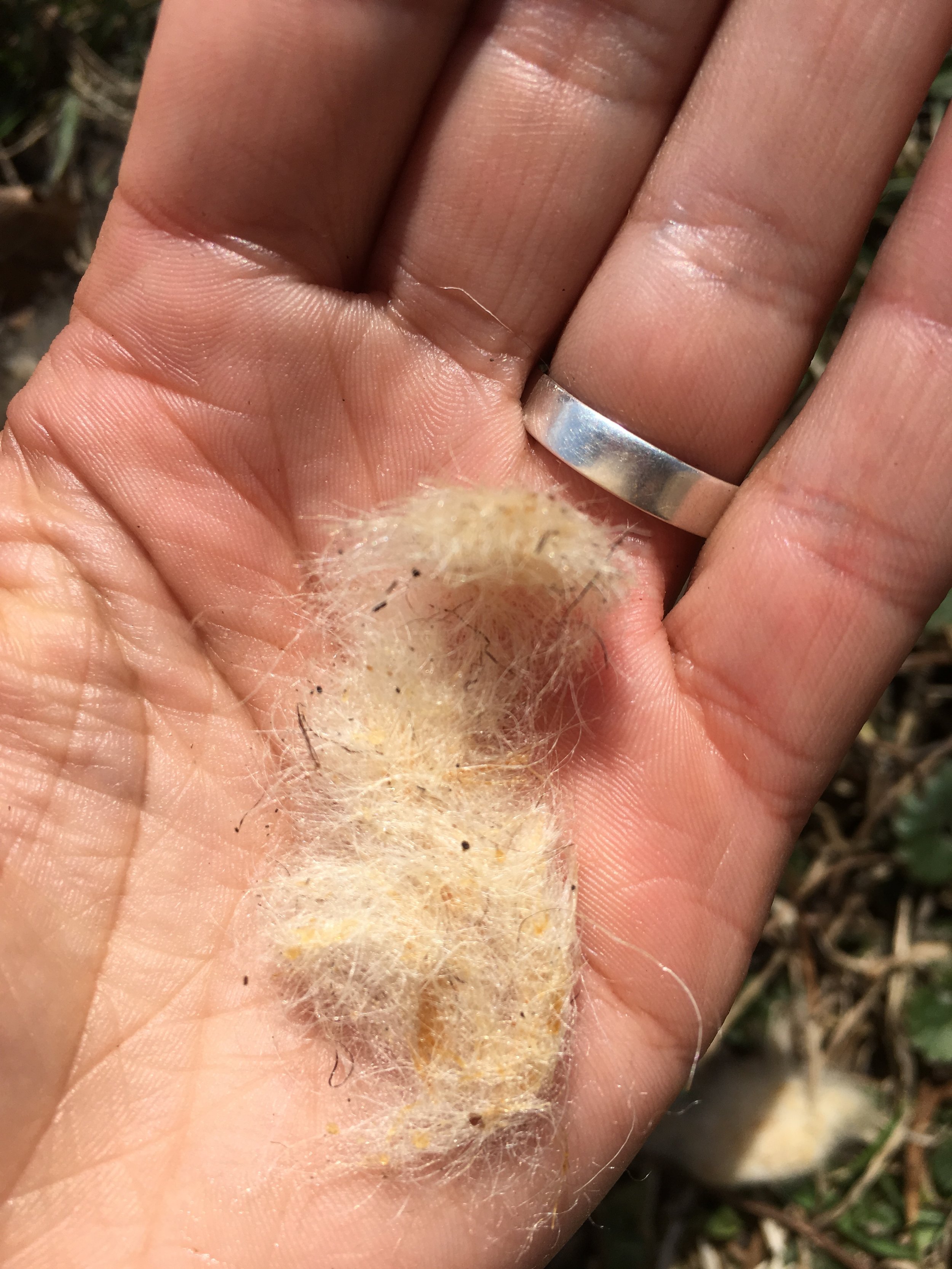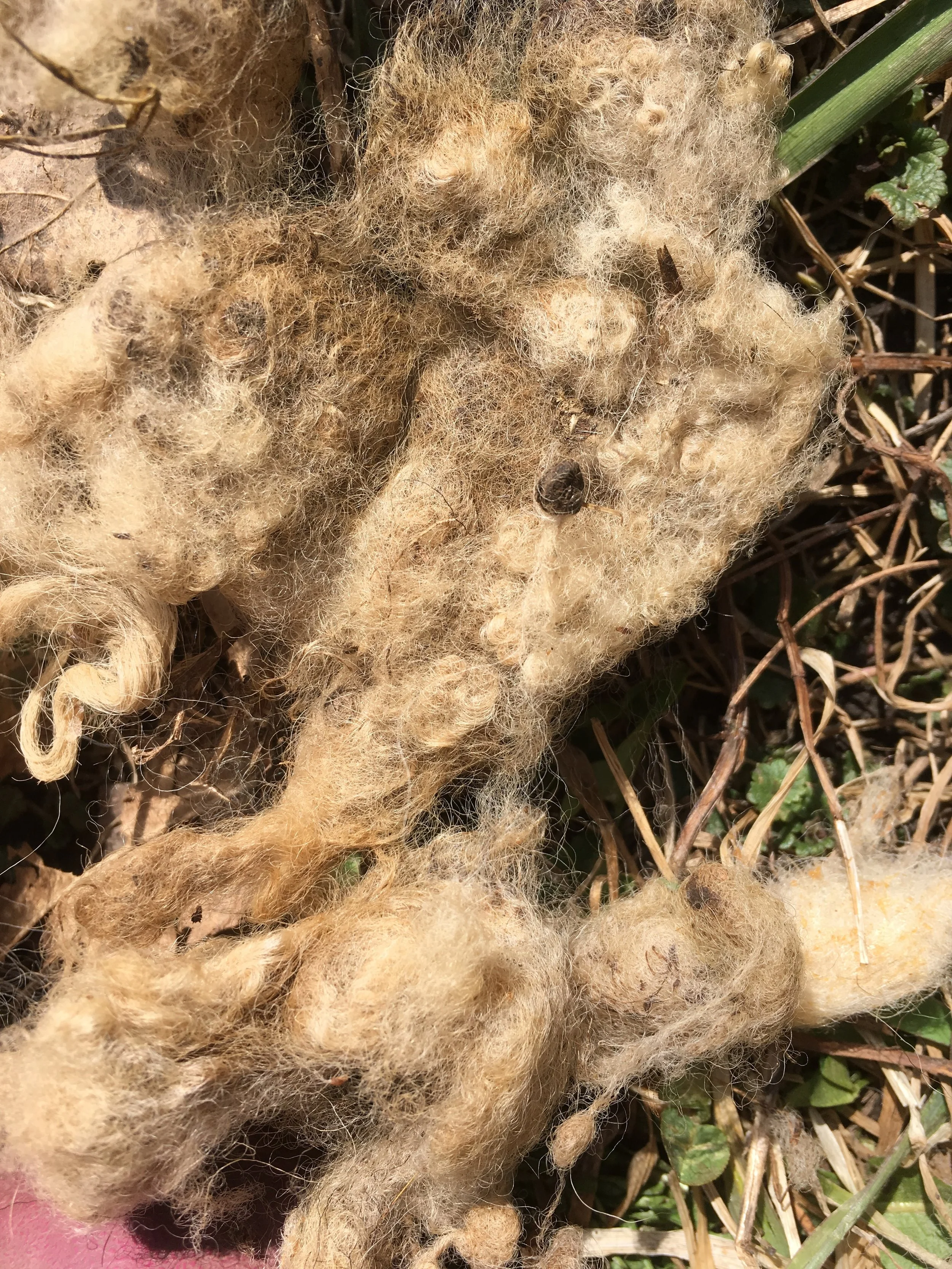How to skirt and Clean a Fleece
Processing Wool: Step one, Cleaning raw sheep's fleece
Hopefully the fleece you have acquired has been professionally sheared. this helps a lot.
When you are ready to skirt your fleece lay the fleece out flat, with the locks facing up.
you will notice that some of the fleece around the edges, where the legs and bottom are, will be very soiled with vegetable matter(VM) and quite probably caked with sheep poo and dirt.
Go around the edges and remove the fiber that is too dirty to use. use it for mulch.
you may also find what are called second cuts.
Second cuts refer to the fiber that has been cut twice by the shearer. where the shearer cut the same area twice, you will sometimes have short fibers that come off.
these fibers are too small to use for spinning.
you can save them if you want to use for other projects, but for now, set them aside.
you may also find fibers that have been felted on the sheep around the back legs.
these are some second cuts, and some felted locks that I found on the fleece and skirted.
sometimes the fiber that goes right across the back is also too saturated in VM to use. these are the areas that i've found that I pay the most attention to when I skirt the fleece.
When your fleece is skirted and you are left with the fiber that you are going to spend time cleaning.
assemble some vessels for holding wool and water. you want your wool locks to lay in a single layer on the bottom of a flat surface.
I use small, shallow plastic tubs, I have seen some very clever uses of plastic tubs with holes in them- so the water will drain out, contained inside a larger tub for the soaking.
you will work in a similar way, as skirting. From the outside in. Pulling out single locks, or clumps of locks.
pull the locks away from the fleece. and if the lock dirty or has some VM tease the lock apart gently.
I like to shake the locks or lock clumps at this time, because some of the VM will fall out.
when you remove a single lock, you will want to cunduct a ping test- hold the lock with both hands between your index fingers and thumbs. pull the lock taut with a quick motion. if your lock stays in tact, then you are good to go.
if your lock breaks at any point, that means that there are weak fibers throughout the fleece, and it is likely that the sheep experienced some sort of stressful experience such as, a change in food, or extreme weather.
this is unfortunate, if you want to use the fleece, you will have to take off the short fibers at the end on each lock cluster or else you will have short fibers when it comes to the spinning stage.
*if you choose to use soap, do some research elsewhere about what soap is going to work best for you. I do not like to use soap, because I prefer to leave the lanolin in the sheep's wool.
I have used dr, bronners baby soap, because it is scentless, non toxic, and does not contain a foaming agent.
you do not need a foaming agent to clean wool.
in my experience using soap did not get the fleece any cleaner- it did however strip away lanolin.
*put soap into your basin.
place the locks into your shallow basins in a single layer and cover with water.
the wool will naturally float to the top because wool is water repellant. use your hands to GENTLY push the wool into the water to immerse it completely.
you do not want to agitate the wool because you can felt the fibers together. you want to take special care to do this gently especially if you are using warm water.
I have used both hot and cold water, and there is not a perceptible difference in the final product.
allow the wool to sit in the water for at least 30 minutes.
this first wash will be quite filthy.
remove the locks from the water gently by lifting them up, and draining them out.
You will want to pour the water outside. since I do not use soap, I pour the water on my garden, and the plants seem to love the nutrients from the wool. If you did use soap, you will need to think more carefully about how you are going to responsibly dispose of your waste water.
place the locks into a second wash. and wait 30 more minutes.
you can continue to separate locks from your fleece while your fiber is soaking, and sort them into more vessels.
you will soon find the locks that are too soiled to use, and those that are usable fibers.
you can at this time tease the locks apart gently if you notice that some dirt or VM is sticking them together. you want the water to do the work for you, and float the muck out of the fiber.
I have found that two washes for me is sufficiently clean to move on to the next step.
if you have used soap, you will need to do additional rinse washes to remove the soap from your fiber.
Remove the fiber from the water and lay out to dry on screens. do not agitate the fiber when it it wet, lay the fiber out gently.
I use old window screens to lay mine out. lay your fiber where there is plenty of air flow. it may take a few days for the fiber to completely dry.
when the fiber is completely dry, you may move on to step two, carding, or you can store the fiber in pillow cases, burlap sacks, or something that breathes until further use.
The total skirting and washing process takes me about 6 hours for a large fleece like this one. with practice I am sure that time will be shortened, but if this is your first fleece and you want it to be clean expect to take some amount of time doing this.
Want to learn more?
Enroll in my fleece to fiber course
you may be wondering why do I do this? well, first, it's my passion and I love it.
It's fueled by a strong calling and responsibility to learn traditional skills, and produce textiles from local fibers.
I try to stay away from depressing statistics, but I read recently that it takes approximately 715 gallons of water to produce a cotton t shirt. We all know that the textile industry sucks up a whole lot of water, I was not aware of the true scope of water usage.
the amount of water I used to wash this wool was 6 gallons, and after carding, spinning, and knitting it, which will take no additional water, I can definitely make at least 2 shirts from this fiber. of course that does not take into account the amount of water that the sheep drank in it's year of making this fleece. however, if the sheep's manure can be used to build soil, and the grazing of the sheep can improve soil health, water retention of soil, and the biodiversity of plant species, I would be so bold as to say that the impact is a positive one for the earth.
end soapbox
Does anyone else have a neat tip they want to share about hand washing wool fleece at home?








